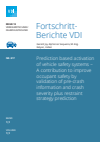Prediction based activation of vehicle safety systems – A contribution to improve occupant safety by validation of pre-crash information and crash severity plus restraint strategy prediction
Zusammenfassung
The world of transportation is rapidly changing with the introduction of partial autonomy in vehicles and the race between the manufacturers to produce a fully automated passenger vehicle. In addition, to enhance driving comfort and reduce the driving workload, these automated vehicles are also visualized as an approach to reduce the majority of accidents that are caused by human errors. However, accidents do happen and there are also some likelihoods that these automated vehicles might fail. Especially in the initial introductory years, which highlights the need for passive safety systems in safeguarding the occupants. These vehicles typically employ forward-looking sensors for the perception of the surrounding environment, which presents an opportunity to use the information from these sensors to predict an upcoming inevitable crash and further estimate the passive safety action required for the predicted crash in the pre-crash phase. This work presents an approach to activate the vehicle safety systems based on the precrash prediction.
Contents
1 Introduction 1
1.1 History of vehicle safety . . . . . . . . . . . . . . . . . . . . . . . . 2
1.2 Problem formulation . . . . ....
Schlagworte
Vorausschauendes Fahrzeugsicherheitssystem Crash-Validierung Prädiktion von Rückhaltstrategie Bestimmung der Fahrzeugkontour Crashschwereschätzung Predictive Safety System Crash Validation Restraint Strategy prediction Contour estimation Crash Severity prediction- 123–125 6 Conclusion 123–125
- 126–162 References 126–162

